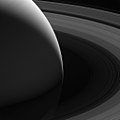
Size of this preview:
600 × 600 pixels. Other resolutions:
240 × 240 pixels |
480 × 480 pixels |
1,020 × 1,020 pixels.
Original file (1,020 × 1,020 pixels, file size: 52 KB, MIME type: image/jpeg)
File history
Click on a date/time to view the file as it appeared at that time.
| Date/Time | Thumbnail | Dimensions | User | Comment | |
|---|---|---|---|---|---|
| current | 17:27, 8 November 2017 |
 | 1,020 × 1,020 (52 KB) | Cogaidh | {{Information |Description ={{en|1=Saturn's graceful lanes of orbiting ice -- its iconic rings -- wind their way around the planet to pass beyond the horizon in this view from NASA's Cassini spacecraft. And diminutive Pandora, scarcely larger than a... |
File usage
The following pages on the English Wikipedia use this file (pages on other projects are not listed):

Size of this preview:
600 × 600 pixels. Other resolutions:
240 × 240 pixels |
480 × 480 pixels |
1,020 × 1,020 pixels.
Original file (1,020 × 1,020 pixels, file size: 52 KB, MIME type: image/jpeg)
File history
Click on a date/time to view the file as it appeared at that time.
| Date/Time | Thumbnail | Dimensions | User | Comment | |
|---|---|---|---|---|---|
| current | 17:27, 8 November 2017 |
 | 1,020 × 1,020 (52 KB) | Cogaidh | {{Information |Description ={{en|1=Saturn's graceful lanes of orbiting ice -- its iconic rings -- wind their way around the planet to pass beyond the horizon in this view from NASA's Cassini spacecraft. And diminutive Pandora, scarcely larger than a... |
File usage
The following pages on the English Wikipedia use this file (pages on other projects are not listed):

